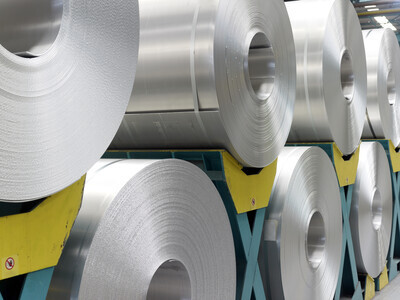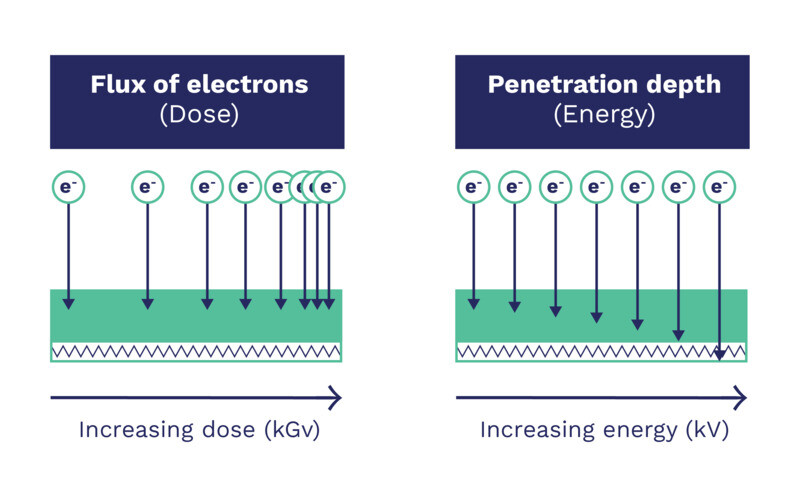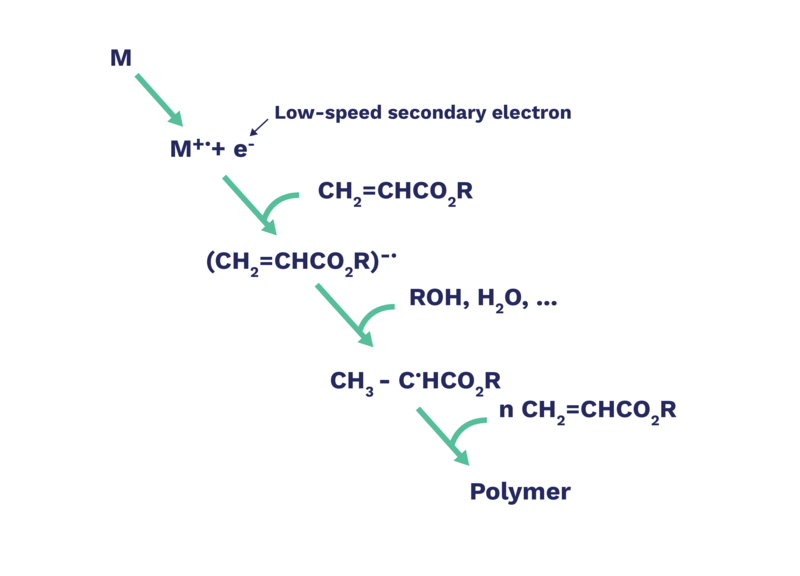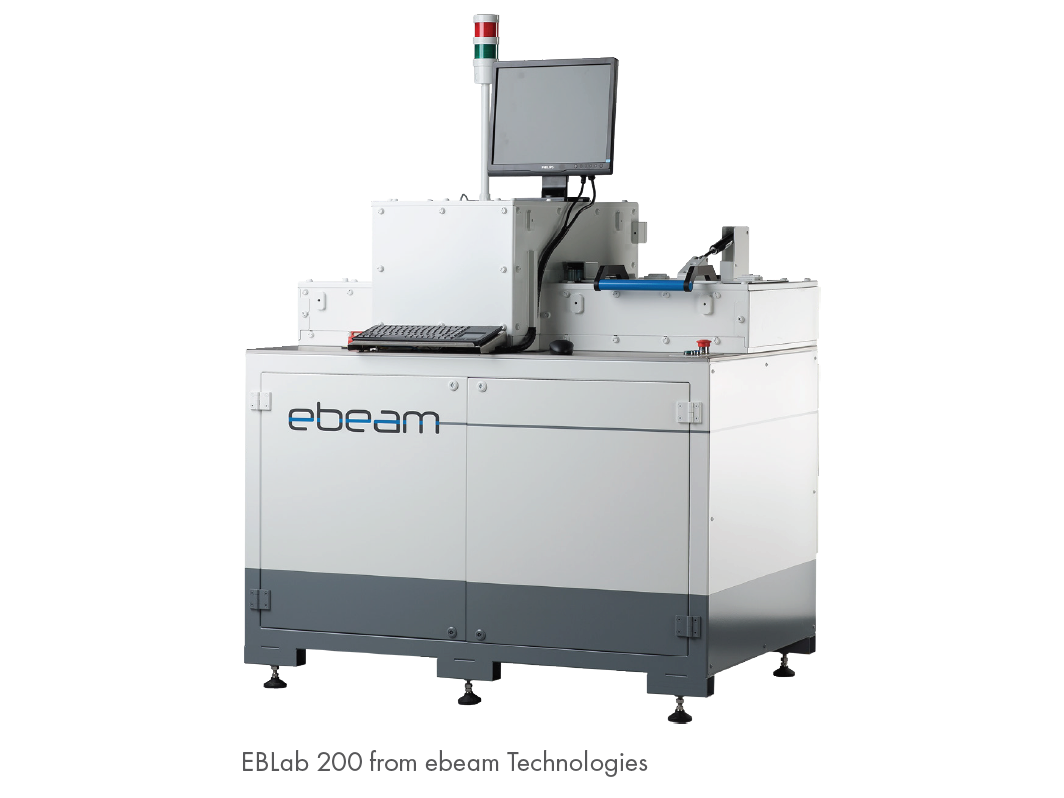EB curing: advanced liquid resin solutions for coatings, inks and adhesives

Electron beam (EB) is a low-VOC, solvent-free technology that provides enhanced properties for coatings, inks and adhesives industries. Arkema develops advanced liquid resin solutions and works with customers to formulate next-generation EB curable materials, increase efficiency and improve their time to market.
Radiation curing: from photos to electrons
| UV | EB | ||||||||||||||||||||||||||||||||||||||||||||||||||||||||||||||||||||||||||||||||||||||||||||||||||||||||||||||||||||||||||||||||||||||||||||||||||||||||||||||||||||||||||||||||||||||||||||||||||||||||||||||||||||||||||||||||||||||||||||||||||||||||||||||||||||||||||||||||||||||||||||||||||||||||||||||||||||||||||||||||||||||||||||||||||||||||||||||||||||||||||||||||||||||||||||||||||||||||||||||||
|---|---|---|---|---|---|---|---|---|---|---|---|---|---|---|---|---|---|---|---|---|---|---|---|---|---|---|---|---|---|---|---|---|---|---|---|---|---|---|---|---|---|---|---|---|---|---|---|---|---|---|---|---|---|---|---|---|---|---|---|---|---|---|---|---|---|---|---|---|---|---|---|---|---|---|---|---|---|---|---|---|---|---|---|---|---|---|---|---|---|---|---|---|---|---|---|---|---|---|---|---|---|---|---|---|---|---|---|---|---|---|---|---|---|---|---|---|---|---|---|---|---|---|---|---|---|---|---|---|---|---|---|---|---|---|---|---|---|---|---|---|---|---|---|---|---|---|---|---|---|---|---|---|---|---|---|---|---|---|---|---|---|---|---|---|---|---|---|---|---|---|---|---|---|---|---|---|---|---|---|---|---|---|---|---|---|---|---|---|---|---|---|---|---|---|---|---|---|---|---|---|---|---|---|---|---|---|---|---|---|---|---|---|---|---|---|---|---|---|---|---|---|---|---|---|---|---|---|---|---|---|---|---|---|---|---|---|---|---|---|---|---|---|---|---|---|---|---|---|---|---|---|---|---|---|---|---|---|---|---|---|---|---|---|---|---|---|---|---|---|---|---|---|---|---|---|---|---|---|---|---|---|---|---|---|---|---|---|---|---|---|---|---|---|---|---|---|---|---|---|---|---|---|---|---|---|---|---|---|---|---|---|---|---|---|---|---|---|---|---|---|---|---|---|---|---|---|---|---|---|---|---|---|---|---|---|---|---|---|---|---|---|---|---|---|---|---|---|---|---|---|---|---|---|---|---|---|---|---|---|---|---|---|---|---|---|---|---|---|---|---|---|---|---|---|---|---|---|---|---|---|---|---|---|---|---|---|---|---|---|---|---|---|---|---|---|---|---|---|---|---|---|
| Form of energy | Photon | Accelerated e- | |||||||||||||||||||||||||||||||||||||||||||||||||||||||||||||||||||||||||||||||||||||||||||||||||||||||||||||||||||||||||||||||||||||||||||||||||||||||||||||||||||||||||||||||||||||||||||||||||||||||||||||||||||||||||||||||||||||||||||||||||||||||||||||||||||||||||||||||||||||||||||||||||||||||||||||||||||||||||||||||||||||||||||||||||||||||||||||||||||||||||||||||||||||||||||||||||||||||||||||||
| Range of energy | 200 to 415 nm | 80 to 300 kV | |||||||||||||||||||||||||||||||||||||||||||||||||||||||||||||||||||||||||||||||||||||||||||||||||||||||||||||||||||||||||||||||||||||||||||||||||||||||||||||||||||||||||||||||||||||||||||||||||||||||||||||||||||||||||||||||||||||||||||||||||||||||||||||||||||||||||||||||||||||||||||||||||||||||||||||||||||||||||||||||||||||||||||||||||||||||||||||||||||||||||||||||||||||||||||||||||||||||||||||||
| Total applied energy | 0.5 J/cm2 | 20 to 40 kGy | |||||||||||||||||||||||||||||||||||||||||||||||||||||||||||||||||||||||||||||||||||||||||||||||||||||||||||||||||||||||||||||||||||||||||||||||||||||||||||||||||||||||||||||||||||||||||||||||||||||||||||||||||||||||||||||||||||||||||||||||||||||||||||||||||||||||||||||||||||||||||||||||||||||||||||||||||||||||||||||||||||||||||||||||||||||||||||||||||||||||||||||||||||||||||||||||||||||||||||||||
| Penetration depends on | Optical density of the material | Mass density of the material | |||||||||||||||||||||||||||||||||||||||||||||||||||||||||||||||||||||||||||||||||||||||||||||||||||||||||||||||||||||||||||||||||||||||||||||||||||||||||||||||||||||||||||||||||||||||||||||||||||||||||||||||||||||||||||||||||||||||||||||||||||||||||||||||||||||||||||||||||||||||||||||||||||||||||||||||||||||||||||||||||||||||||||||||||||||||||||||||||||||||||||||||||||||||||||||||||||||||||||||||
| Penetration control | Peak irradiance (power and focus) of the UV source | Acceleration voltage of the beam | |||||||||||||||||||||||||||||||||||||||||||||||||||||||||||||||||||||||||||||||||||||||||||||||||||||||||||||||||||||||||||||||||||||||||||||||||||||||||||||||||||||||||||||||||||||||||||||||||||||||||||||||||||||||||||||||||||||||||||||||||||||||||||||||||||||||||||||||||||||||||||||||||||||||||||||||||||||||||||||||||||||||||||||||||||||||||||||||||||||||||||||||||||||||||||||||||||||||||||||||
| Easily penetrates | Clear materials | Clear, pigmented, filled and opaque materials | |||||||||||||||||||||||||||||||||||||||||||||||||||||||||||||||||||||||||||||||||||||||||||||||||||||||||||||||||||||||||||||||||||||||||||||||||||||||||||||||||||||||||||||||||||||||||||||||||||||||||||||||||||||||||||||||||||||||||||||||||||||||||||||||||||||||||||||||||||||||||||||||||||||||||||||||||||||||||||||||||||||||||||||||||||||||||||||||||||||||||||||||||||||||||||||||||||||||||||||||
Why use electron beam curing?
Benefits of EB Curing:
In addition to the lower energy-consumption benefits of radiation curing technologies,
- No photoinitiators required ➞ minimized and low migration
- High degree of conversion
- Very high speed achievable allowing deep penetration for thick coatings
- N2 atmosphere needed to avoid O2 inhibition
- High energy radiation
- Improved dot gain control
- No heat for sensitive substrates
- High performance: gloss, scuff and abrasion resistance
- Suitable for highly pigmented formulations
➔ CURING OF THICK AND OPAQUE FILMS
➔ LOW RISK OF MIGRATION
Principle of the technology
Inside an ultra high vacuum chamber, an incandescent filament generates electrons. Then, the electrons are accelerated by a strong electrical field and exit the chamber through a thin titanium window.
Two variables matter particularly, the intensity (number of electrons generated per second) applied to the filament and the tension applied to accelerate these electrons.
The key parameters
With the EB curing technology, there are two key parameters that you can tune separately and independently from each other :
- The dose (kGv) influences the flow of electrons: raising it is equivalent to increasing the number of electron hitting a certain surface area
- The energy (kV) influences the penetration depth: increasing the energy is equivalent to amplifying the power of electrons that penetrate into the surface

Interaction with matter
Let us imagine an electron penetrating an acrylate monomer/oligomer formulation to approach the interaction with matter.
An electron comes from the top, some collisions occur while penetrating the substrate. That the results of energy generation, the electron loses his energy along the trajectory and this energy is deposited in the matter.
- The energy is high (or the coating is thin), the electron goes all the way through the substrate
- The energy is low (or the coating is thick), the electron is absorbed by the matter
When the energy is deposited (red crosses), secondary slower electrons (blue circles) may be generated; they are slower than primary electrons.
Initiation mechanism
The low speed secondary electrons produced are solvated by the acrylate and allows the formation of a radical anion. Then, the protonation (coming from impurities or traces of water) of this radical anion generates a free radical species. A free-radical initiated specie is produced and allow the polymerization start.

Thus, a primary electron generates many free radicals that will initiate the polymerization reaction. The higher the primary electron energy is, the more free radicals are generated.
Full service support for your projects
We can provide a unique service offering to help prospective customers perform feasibility studies in our lab. We combine deep know-how in (meth)acrylate chemistry with state-of-the-art laboratory equipment, to help you enhance the performance of EB curing in your existing applications, or test and develop proof of concept of new ideas.
Our lab service :
- EBLab machine from 80 to 200 keV, format A4 up to 30m/min
- Formulation lab and access to the whole Sartomer® product portfolio
- Technical support and expertise
- Chemical and physical characterization on site

The addition of the EB lab units is part of our dedication to working with our customers to find the best and most efficient curing systems. It is a promising technology that enables high-quality finished products, and we’re excited to offer customers the ability to expand their range of applications and give them a competitive edge in the marketplace.
Solution expertise and dedicated materials
Our Sartomer® materials significantly boost the benefits of EB curing by enhancing properties:
-
High gloss
-
Abrasion resistance
-
Deep penetration
-
High-speed processing
Through material design and formulation fine-tuning, our products can support you to achieve a broad range of properties.
